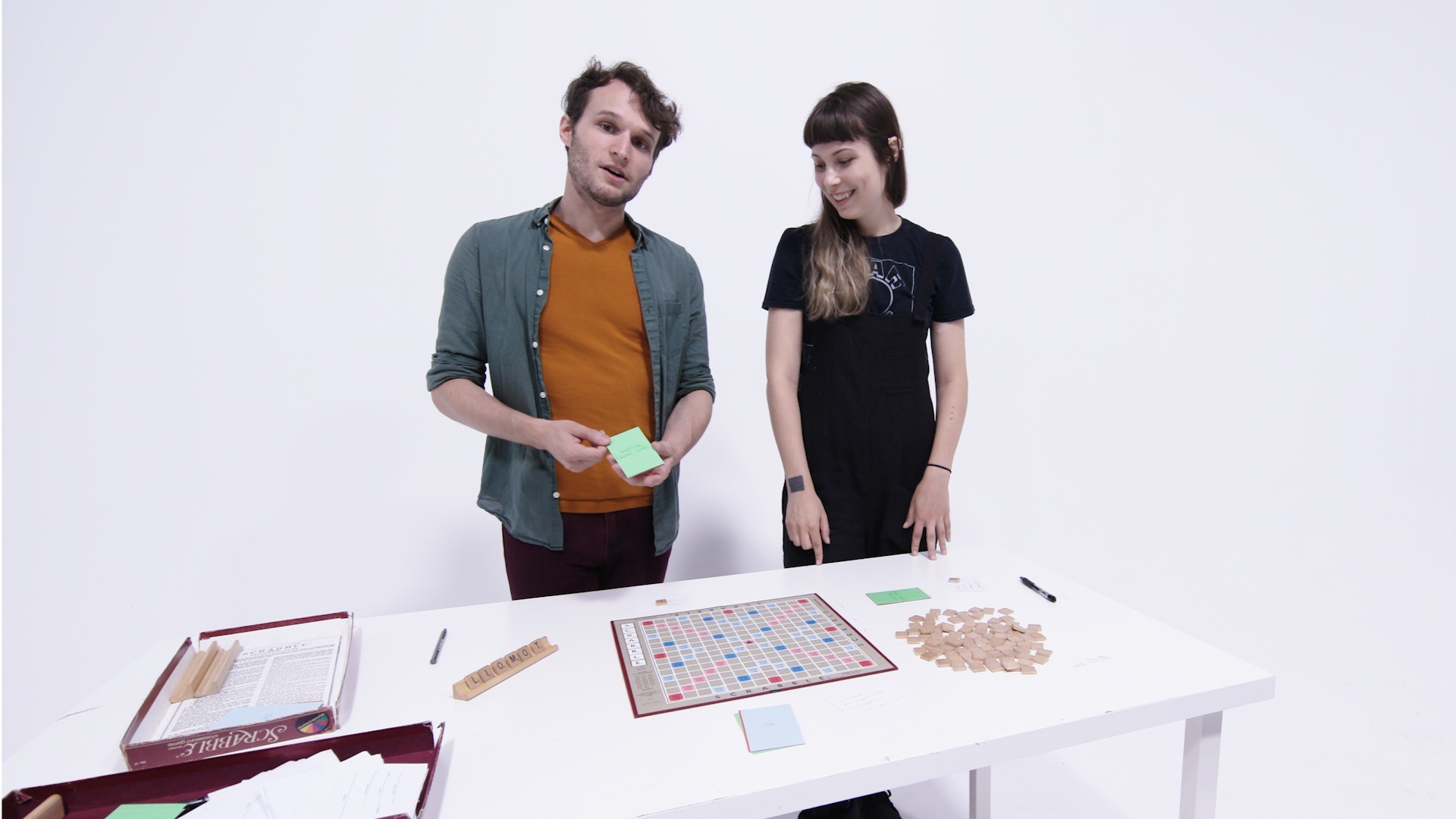Image: Author
I know absolutely nothing about blockchains, the “decentralized ledgers” supposedly revolutionizing everything from finance to real estate. Nodding along to conversations at office parties, I think I’ve picked up that they have something to do with digital currency, or maybe some sort of loyalty program?Over the weekend I decided to go to a session called “Understanding Blockchains with Scrabble” at the 2018 Our Networks conference in Toronto, Ontario. The session sounded doubly informative, because I have also never played a full game of Scrabble. I once tried but didn’t immediately win at it and thus decided it was The Devil’s Game. Cheerfully missing the 2018 World Cup finals on Sunday morning, seven other people joined me to learn more about blockchains at the session. Led by software engineers Sarah Friend and David Wolever, the session broke down the basics of blockchains and explained them with “Scrabits,” the creators’ modified version of Scrabble.Despite being the person who knew the least in the room, I walked away feeling like I had a pretty good handle on the technology. Friend and Wolever cautioned that the game is a simplified version of how blockchains really work (Scrabits ignores, for example, the possibility of a kind of sabotage known as a 51 percent attack). But it’s still helpful for learning the basics. Let’s play:The conceptA blockchain is a digital ledger of transactions that is maintained by a global community of people forming a vast network of checks and balances, and so no trusted central authority is needed to keep track of everything. Digital money such as Bitcoin is one of the most popular applications of blockchain technology, but supply chain management and even real estate are other potential applications. In Scrabits, the Scrabble board is the blockchain.The rules of Scrabits (and blockchains) are set, Friend told me, as “a way for a group of people who don’t trust each other to agree on the state of their network.” Wolever chimed in: “Which is usually financial,” he said.Scrabits isn’t a competitive game, per se, and it encourages players to work together on different aspects of what makes a blockchain tick. Scrabble points are transformed into “Scrabits” (essentially bitcoins) that players rack up when they spell a word, which is the in-game equivalent of mining a block of Bitcoin transaction data.Real-world cryptocurrency mining operations run server farms around the world 24 hours a day to crunch numbers and solve a block of bundled Bitcoin transactions, adding them to the blockchain. It’s a global, simultaneous competition involving brute force and luck, and miners receive newly minted bitcoins as a reward for solving a block.2) blank transaction cards for future transactions. All valid transactions must state the name of the sender, the number of Scrabits being sent, the name of the receiver, and the signature of the sender.3) three difficulty cards. At first, the board accepts words that are four or more letters long, but if half of the players change the speed of the game by putting down their “slower” cards, the board will only accept words that are five or more letters.In the middle of the table, players share a Scrabits board (the blockchain) and one tile rack (this is the mempool, the blockchain’s backlog of transactions not yet mined into a block). In Scrabits the mempool always has six tiles, which players are free to use to complete their words. Players can see the letters on mempool tiles, and as tiles get used, more are randomly pulled from the Scrabble tile bag and put into the mempool.How to playPlayers aim to earn points called Scrabits by forming as many words as they can on the board, as quickly as they can. Each completed word on the board earns Scrabits, the in-game equivalent to block rewards.Let’s say Satoshi Nakamoto (the pseudonymous creator of Bitcoin) starts off the game by forming the word “RUIN” (using three tiles from the mempool and one from his own stash). Normal Scrabble points would be tallied (in this case, 1, 1, 1, 1) and thanks to a double word score, he earns eight points) and Nakamoto would now have 58 points. This creates a transaction.Nakamoto then decides on the outputs for this transaction—they could fill out a transaction card giving themselves eight Scrabits; or give four Scrabits to a friend, and four back to themselves; or Nakamoto could acquire more tiles by giving themselves eight transaction cards of one Scrabit each (given that each card comes with a tile). If you have eight completed transaction cards in front of you, that means you have eight tiles. As you use the tiles, you give away the transaction cards.This is somewhat analogous to how transactions work on the blockchain; if you send half a bitcoin to someone but only have one whole bitcoin as an input, a “change” address is created that sends the rest back to you.Every player does this more or less concurrently, making Scrabits a bit of a chaotic free for all—for the sake of having fun (and unlike real blockchains) the folks I played Scrabits with were happy to pause the game while one player formed their word and sent their transactions.How to winAs more words are mined, the pool of Scrabits only grows larger and players richer. Players could tally up their points to see who came out on top once the board is filled or they run out of tiles, but we didn’t bother. Everyone’s a winner in Scrabits—especially those of us who had no idea what a blockchain was before, or that knowing the word “QUARK” (10, 1, 1, 1, 5) could one day come in handy.Solve Motherboard’s weekly, internet-themed crossword puzzle: Solve the Internet.
Cheerfully missing the 2018 World Cup finals on Sunday morning, seven other people joined me to learn more about blockchains at the session. Led by software engineers Sarah Friend and David Wolever, the session broke down the basics of blockchains and explained them with “Scrabits,” the creators’ modified version of Scrabble.Despite being the person who knew the least in the room, I walked away feeling like I had a pretty good handle on the technology. Friend and Wolever cautioned that the game is a simplified version of how blockchains really work (Scrabits ignores, for example, the possibility of a kind of sabotage known as a 51 percent attack). But it’s still helpful for learning the basics. Let’s play:The conceptA blockchain is a digital ledger of transactions that is maintained by a global community of people forming a vast network of checks and balances, and so no trusted central authority is needed to keep track of everything. Digital money such as Bitcoin is one of the most popular applications of blockchain technology, but supply chain management and even real estate are other potential applications. In Scrabits, the Scrabble board is the blockchain.The rules of Scrabits (and blockchains) are set, Friend told me, as “a way for a group of people who don’t trust each other to agree on the state of their network.” Wolever chimed in: “Which is usually financial,” he said.Scrabits isn’t a competitive game, per se, and it encourages players to work together on different aspects of what makes a blockchain tick. Scrabble points are transformed into “Scrabits” (essentially bitcoins) that players rack up when they spell a word, which is the in-game equivalent of mining a block of Bitcoin transaction data.Real-world cryptocurrency mining operations run server farms around the world 24 hours a day to crunch numbers and solve a block of bundled Bitcoin transactions, adding them to the blockchain. It’s a global, simultaneous competition involving brute force and luck, and miners receive newly minted bitcoins as a reward for solving a block.2) blank transaction cards for future transactions. All valid transactions must state the name of the sender, the number of Scrabits being sent, the name of the receiver, and the signature of the sender.3) three difficulty cards. At first, the board accepts words that are four or more letters long, but if half of the players change the speed of the game by putting down their “slower” cards, the board will only accept words that are five or more letters.In the middle of the table, players share a Scrabits board (the blockchain) and one tile rack (this is the mempool, the blockchain’s backlog of transactions not yet mined into a block). In Scrabits the mempool always has six tiles, which players are free to use to complete their words. Players can see the letters on mempool tiles, and as tiles get used, more are randomly pulled from the Scrabble tile bag and put into the mempool.How to playPlayers aim to earn points called Scrabits by forming as many words as they can on the board, as quickly as they can. Each completed word on the board earns Scrabits, the in-game equivalent to block rewards.Let’s say Satoshi Nakamoto (the pseudonymous creator of Bitcoin) starts off the game by forming the word “RUIN” (using three tiles from the mempool and one from his own stash). Normal Scrabble points would be tallied (in this case, 1, 1, 1, 1) and thanks to a double word score, he earns eight points) and Nakamoto would now have 58 points. This creates a transaction.Nakamoto then decides on the outputs for this transaction—they could fill out a transaction card giving themselves eight Scrabits; or give four Scrabits to a friend, and four back to themselves; or Nakamoto could acquire more tiles by giving themselves eight transaction cards of one Scrabit each (given that each card comes with a tile). If you have eight completed transaction cards in front of you, that means you have eight tiles. As you use the tiles, you give away the transaction cards.This is somewhat analogous to how transactions work on the blockchain; if you send half a bitcoin to someone but only have one whole bitcoin as an input, a “change” address is created that sends the rest back to you.Every player does this more or less concurrently, making Scrabits a bit of a chaotic free for all—for the sake of having fun (and unlike real blockchains) the folks I played Scrabits with were happy to pause the game while one player formed their word and sent their transactions.How to winAs more words are mined, the pool of Scrabits only grows larger and players richer. Players could tally up their points to see who came out on top once the board is filled or they run out of tiles, but we didn’t bother. Everyone’s a winner in Scrabits—especially those of us who had no idea what a blockchain was before, or that knowing the word “QUARK” (10, 1, 1, 1, 5) could one day come in handy.Solve Motherboard’s weekly, internet-themed crossword puzzle: Solve the Internet.
Advertisement

Advertisement
Scrabits players act like miners who form new words (blocks) for points (block rewards). Unlike in Scrabble, there are no turns—whoever spots a word can form it. Players can also send Scrabits to each other in transactions that are considered valid only after a miner completes a word.“Mining is like a guessing-game speed race,” says Wolever, and the more people trying to mine, the longer it will take for each of them to do so successfully. This is because the computational difficulty of finding the next correct hash gets algorithmically ratcheted up or down based on how quickly or slowly blocks are being solved; in Scrabits, blockchain difficulty is gamified into cards that players can deploy to speed up or slow down the game.How to set up the gameEach player starts with:1) an initial transaction input of 50 Scrabits (50 points) with a random letter tile assigned to it—a “hash.” In a blockchain, each transaction is given a hash as a form of ID that lets anyone look it up on the public ledger.Read More: The Motherboard Bitcoin and Ethereum Primer
Advertisement
Advertisement
